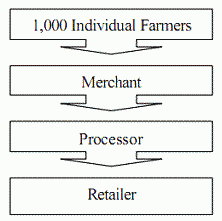Corporate VMS
Category: Marketing
Vertical integration with ownership of organisations at several levels into the channel network constitutes a corporate VMS. Manufacturers may establish their own retail outlets such as brewers or oil companies. Retailers may own manufacturing processing or packaging plants. Under common ownership the entire operations of the channel can be regulated to minimise the possibility of suboptimisation at any particular level in the network.
All of the above types are evident in product channels. They are also possible in service channels. But there are often additional considerations, which shape service channels. For instance in hotel marketing channels the intermediary could be a transit operator, a tour operator or a travel agent. The
first two may or may not work through a travel agent, and the channel could be consensus or vertically integrated by one of these intermediaries. For other services the channel could be very simple composed entirely of independents without intermediaries, or with some kind of franchise operation. Therefore, depending upon the nature of the service, the channel could be highly complex or very simple and so the problems in the organisation and control of channel activities are highly variable. With a wide range of channel options this also means that the possibilities for channel innovation offer great scope. Such possibilities are enhanced where the service has communication as an inherent part of its value to the buyer.
Developments in communication technology allow quite novel channels to emerge to co-ordinate previously disparate service points and to inspire the parallel provision of service in one channel which may have been separately provided in several channels before.
As sell as having a vertical dimension, channels do of course also have a horizontal dimension. Integration can occur horizontally as well as vertically.
For example, a traditional agricultural marketing channel may consist of 1 000 individual farmers supplying, on an individual basis, a merchant who then supplies a processor who then supplies a retailer.
Horizontal integration of the production and/or marketing functions of the 1 000 farmers can take place at that level of the channel. This forms the basis for all forms of producer co-operatives and marketing boards in the agri-food area, the rationale being that such horizontal integration gives the farmers a power members channel merchant.
Lamont (1991) provides a useful analysis of how both horizontal and vertical integration in an agri-food export marketing channel can improve overall marketing efficiency and performance.

